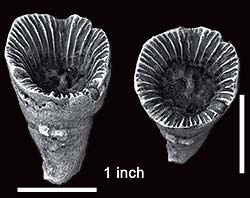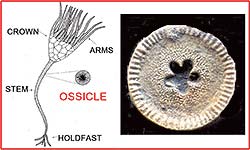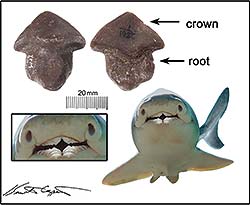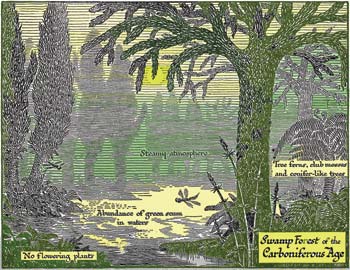|
|
PALEO HAPPENINGS February 2021 |
| A Green Coast and a Beautiful 300-Million-Year Old Seaby Martin Lockley, Moab Giants |
 |
| Horn corals, typical of 300-million-year-old marine faunas found near Moab, indicate warm seas. |
Say wild west Moab and we think of dusty deserts and towering, red rock monuments, not clear blue waters and sharks around tropical reefs. But that was Moab 300-million years ago. The Moab area holds a long record of life on land, but there were times when the seas encroached. Early Paleozoic seas rolled in 500-million-years ago during the Cambrian Period, leaving countless trilobite fossils during the so-called the “Age of Trilobites” (see Paleo Happenings January 2020 at moabhappenings.com/Archive/000archiveindex.htm). Another Late Paleozoic episode of marine incursion occurred during the Pennsylvanian Period some 300 million years ago. The sea was “beautiful” and richly fossiliferous: its deposits, aptly named as the Hermosa Group, accumulated below a tropical sea teaming with life and situated not far from the equator.
The Pennsylvanian Period named, you guessed it, after strata in Pennsylvania, was pivotal in Earth History. The rich life that had evolved in the seas, was beginning to a spread onto the continental margins via rivers and coastal areas. Pennsylvanian rocks are equivalent to what is called the Carboniferous “age of coal swamps and amphibians” strata around the world. (Coal = carbon in Spanish). These 300-million-year-old coastal coal swamps mark
 |
| Crinoids or “sea lilies” are sea urchin relatives with stems several feet long. They were very common in Paleozoic seas. The stem segments known as “ossicles” were used for decoration by native Americans. |
the location of today’s Pennsylvanian and European coal fields that helped fuel the industrial revolution. [Utah’s coals are
geologically much younger, from the ‘Age of Dinosaurs’]. A Carboniferous time lapse sequence would have shown a flush of green spreading across the lowlands as the first true forests took root, adding extra oxygen to the atmosphere. Niches below the canopy of primitive spore-bearing plants, like giant, tree-sized club mosses were home to diverse arthropods including giant millipedes, dragonflies, the latter among the first animals to fly. In the swampy lowlands, specialized fish had already evolved into air-breathing, salamander-like amphibians, some already with primitive, reptilian characteristics: both had short legs taking small steps as individuals, but giant steps for vertebrate evolution.
An offshore swim, and dive below the beautiful Hermosa sea would reveal a quite different world: both familiar and different. Seaweeds, corals, starfish, mollusks and fish might look similar but the species were all different. Big-brained cephalopod mollusks resembled today’s pearly Nautilus, but what are those long stemmed plant-like creatures, waving in the currents like a field of flowers? They are crinoids otherwise known as “sea-
 |
| Petal-shaped teeth give this 300-million-year-old shark the name Petalodus. The author has found examples in the area. Artwork by Kenneth Carpenter, former director of the Prehistoric Museum in Price. |
lilies,” animals, not plants, relatives of the starfish and sea urchin. Thousands of circular stem segments, or ossicles, shaped like buttons or life savers, caught the eye of native Americans, and were among the first fossils ever used for adornment. They were so abundant, that, like the corals, mollusks and clam-like brachiopods that thrived in the warm tropical seas, they produced copious calcite skeletons that accumulated to produce today’s thick limestone deposits.
The top predators were sharks, with soft cartilaginous skeletons, they were likely the most mobile of fish and also the largest: some sharp-toothed, others blunt-toothed shell crushers. A Pennsylvanian “super shark” from Texas may have been 6-7 meters (20-23 feet) long. Because sharks had resistant enamel teeth and fin spines that make better fossils than their soft cartilage skeletal parts, they are not impossible to find if you know the right places to look. A beautiful sea world once existed below the beautiful Hermosa sea, and the beautiful fossils are still to be found.
 |
|
|
|
|
|
© 2002-2024 Moab Happenings. All rights
reserved.
Reproduction of information contained in this site is
expressly prohibited.
|
|



